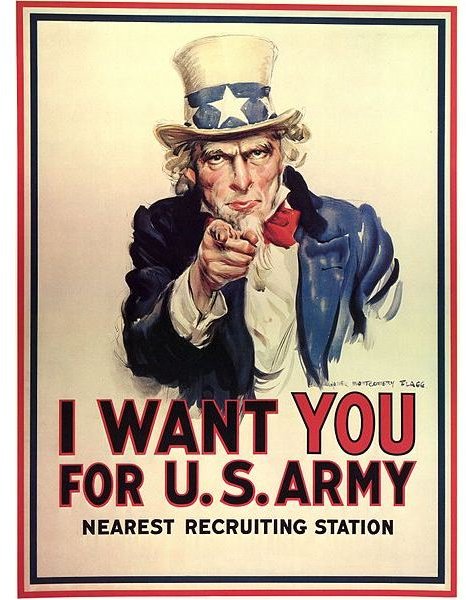Uncle Sam, the Symbol of American Government: Origins, History and Meaning
Who–or What–Is Uncle Sam?
“Uncle Sam,” “Big Brother” and “Yankee Doodle” have one thing in common — they are symbols of government. Each symbol personifies the government in a different way: the fatherly, sometimes overbearing Uncle Sam; the oppressive, snooping Big Brother of “1984” fame; and the spirited, industrious Yankee Doodle. Why do people feel the need to personify government? Where do symbols like these come from?
Origins of Uncle Sam
There are several versions of the story of Uncle Sam. The official version, confirmed by Congress in 1961, dates Uncle Sam back to the War of 1812. Samuel Wilson ran a meat-packing and distribution business, and was known locally in his Massachusetts town as “Uncle” Sam. During the War of 1812, he supplied meat to the U.S. Army. The boxes were stamped with “U.S.” for United States, which the soldiers joked meant “Uncle Sam” for the man who was supplying their food. Uncle Sam became a symbol of how a lone patriot could help his country in a time of crisis.
As the years passed and the legend grew, the symbol of Uncle Sam developed to reflect the times. Samuel Wilson was middle-aged; however, the image of Uncle Sam of a few decades later bore little resemblance to the actual person it was based on. Uncle Sam aged and acquired patriotic attire. When Abraham Lincoln became President, Uncle Sam and his “nephew” Yankee Doodle, a symbol from the Revolutionary War, took on new meaning as patriotic symbols of the North. Uncle Sam also acquired Lincoln’s facial hair and his signature top hat. Also during the Civil War, American cartoonist Thomas Nast was the first to depict Uncle Sam in political cartoons. As well as Uncle Sam, Nast set the symbols of the Democratic donkey, the Republican elephant and Santa Claus firmly in the mind of American culture.
Uncle Sam as a Recruiter Symbol
Uncle Sam dates back to the War of 1812, but the iconic “I want YOU!” poster was created by James Montgomery Flagg as a recruiting tool for World War II. An old man in patriotic, red-white-and-blue top hat and suit points directly at the viewer, his glare and pointing finger almost accusing. “How could you not fight for your country?” he seems to demand.
Part of the poster’s power and success comes from its individualized approach. “I want some young men” or “I want some recruits” does not have nearly the impact of “I want YOU!” The poster makes eye contact; it singles you out with a pointing finger; its message is personalized. There’s no chance to escape as one in the crowd of potential recruits: Uncle Sam wants you. The effect of this is intimidating, but can also be strangely inspiring. Certainly it worked well at the time — during World War II, the United States was more united as a nation, more patriotic and more pro-military than it ever was before in its history, or has ever been since. The idea that even you — one person — could help your country and make a difference in a global war inspired patriotic pride. Or, if it did not always inspire pride, it at least reminded a potential recruit of duty. It’s much more difficult to worm out from under Uncle Sam’s pointing finger and accusing glare when they are directed specifically at “YOU.” The poster does not allow you to slip away into the crowd.
Uncle Sam in Political Cartoons and Parodies
As the children of the 1960s and 70s rebelled against their parents’ generation and the Vietnam War brought anti-war and anti-patriotism sentiment to its peak, Uncle Sam changed again. The “I want YOU!” poster, once a symbol of patriotism and bravely helping one’s country, was now seen with cynicism and resentment. Overall, the perception of Uncle Sam has changed from a fatherly, if stern, figure to a more overbearing and pompous one. In the current American political climate — with the economic recession and the war in Iraq and Afghanistan — patriotism has gone out of fashion, as it were.
Uncle Sam, the quintessential American symbol, has been endlessly parodied in political cartoons and on the Internet at large with a mixture of playful amusement and genuine resentment. Generally, these parodies imitate the iconic WWII poster with mock “slogans” like “I want YOUR taxes” and “I want YOU to pull my finger!”
Uncle Sam Today
Despite shifting times and numerous parodies, Uncle Sam remains a powerful symbol of patriotism and the American government. Men dressed in Uncle Sam costumes are still a feature of Fourth of July parades around the country. The 1976 children’s novel and Newberry Medal Winner “The Westing Game” features the eccentric Sam Westing, an immigrant turned millionaire who styles himself as “Uncle Sam” and throws extravagant Fourth of July parties. The book, still featured in the elementary school curriculum, teaches patriotic spirit, symbols and heritage.
Though the modern attitude toward patriotism is definitely more cynical than it was in the early 20th century, Uncle Sam nonetheless remains a relevant symbol. In some ways, perhaps he is relevant as a symbol of idealism that has been lost, or a patriotic ideal that America is constantly striving to reach. Either way, Uncle Sam and his message–that one person can make a difference to his or her countr–is as important now as it was in 1812.
References
- University of Virginia American Studies. “Forgotten Origins: Uncle Sam.” http://xroads.virginia.edu/~cap/sam/sam.htm. Accessed 6 Aug 2011.
- Hines, Judith D. The New Book of Knowledge, Vol. 13 (N). “Nast, Thomas (1840-1902).” Grolier Publishing Company, Inc., 2002.
- Image: Uncle Sam Wants You by James Montgomery Flagg under Public Domain.
